Crocheted napkins create coziness in the house. They can be placed under a vase of flowers or used for table setting, decorating rooms. You can create starched napkins not only with starch, but also with other improvised means.
Why starch knitted napkins
Napkins are knitted using the yarns “Iris” and “Snowflake”. These threads make beautiful products that are good to starch. While the product is being knitted, due to the weaving, the napkin becomes wrinkled and does not hold the desired shape. To make it less dirty and stiff, it is recommended to starch it. Thanks to this procedure, the threads are covered with a protective film.
They look thicker, protected from dust and any dirt, while the product:
- becomes dense and elastic;
- slightly bleached and becomes glossy;
- loses its susceptibility to dirt: threads covered with a film are not saturated with dust and moisture.
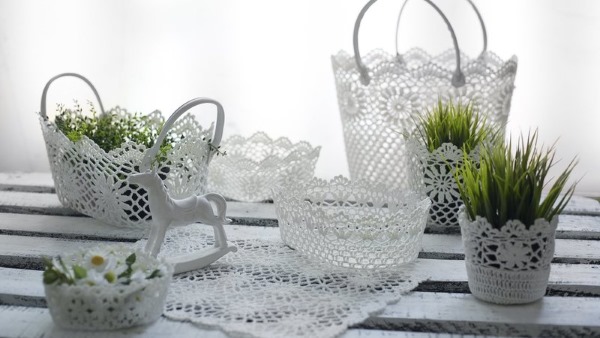
Napkins most often serve as decoration for a coffee table, bedside table, chest of drawers. Thanks to them, it becomes possible to cover up the flaws on furniture. After starching, a napkin can easily be turned into three-dimensional objects - a vase or a candy mold. Most often, items made of white threads - cotton or linen, which are easily subject to this procedure, are starched.
Basic rules and what to prepare for starching
Before you start starching the napkin, you need to:
- Wash. To do this, it is better to first soak knitted items in warm water with the addition of washing powder for hand washing.
- Rub lightly with gentle movements.
- Rinse well. If the napkins are knitted from natural fibers, it is necessary to remember: they can shrink, so it is better to use warm water. You should be especially careful with woolen products.
If there are several napkins, they can be washed in a washing machine. After rinsing, it is recommended to proceed to starching. The duration of the procedure largely depends on the thickness of the yarn. If it is thin, then the napkin is placed in the prepared paste, this procedure lasts about 5 minutes, when thick yarn is used, the time is 10 minutes.
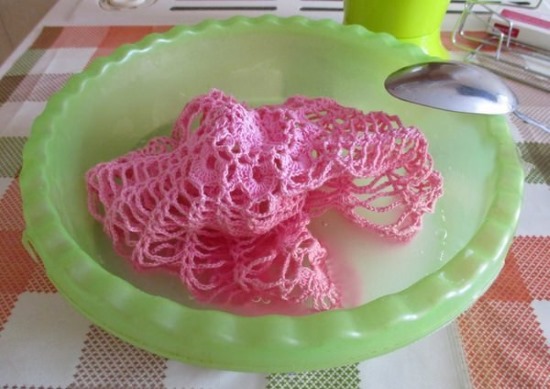
Then the product is slightly squeezed out and laid out on a flat surface to dry. It is important to remember: only when the product is not completely dry, and a slight dampness is felt in it, can the napkin be given the necessary shape.
You can starch a crocheted napkin with either starch or other household components, but Before the procedure itself, you need to prepare:
- pins with heads: that is, with beads on the end;
- wire for aligning the edges;
- ruler;
- bowl for the solution;
- spray;
- white paper;
- towel or white sheet;
- wide brush;
- drying surface;
- form for volumetric products.
Traditional recipe with starch
A frequently used method is starching with potato starch. It is easy to prepare by mixing starch and water. This gives a thick, paste-like consistency that will make the product harder and whiter.
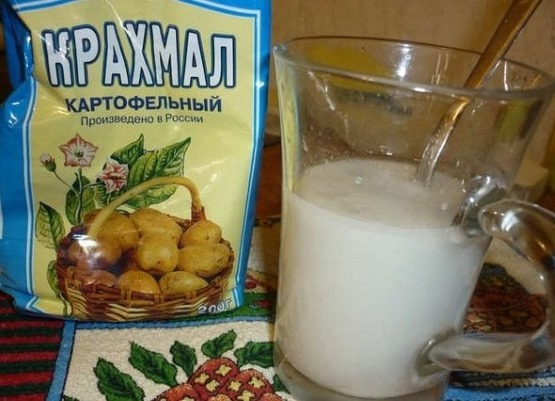
Some housewives like to use starch obtained from corn or rice. However, to give the greatest thickness, you will have to add much more of this starch than potato starch.
Solution concentration
The hardness of the products, after starching, largely depends on the concentration of the prepared pastes:
| Solution concentration | Preparation |
| Weak | To obtain it, 0.5 teaspoon of starch is added to 500 mg of water. This is applicable so that the napkin becomes too hard and its edges hang down slightly |
| Medium hardness | The solution is obtained by adding 0.5 teaspoon to 500 ml of water. The napkins come out hard and they hold any shape well. |
| Hard | In this case, 1 tbsp. of starch is added to 500 ml of water. Such a napkin can easily be made voluminous. It can become a vase for artificial flowers or an openwork bowl. |
Starching algorithm
Not everyone knows how to starch a crocheted napkin correctly.
Much depends on the cooking of the paste, the preparation order of which consists of the following stages:
- Add starch to cold water and mix thoroughly to avoid lumps. If they form, it is recommended to pass it through a sieve.
- Bring the other portion of water to a boil.
- Pour the starch solution in a small stream, stirring constantly with a spoon.
- Continue stirring until the liquid boils again.
- Turn off the heat and wait until the paste cools to 35° C.
There are cases when starch has impurities, and then when mixed with water, dust particles are formed. To achieve the removal of impurities, it is necessary to add starch to cold water, wait a little and drain it, then pour it again, mixing everything and so on until the water becomes clear.
When starching a napkin, you must follow the following algorithm:
- Pour the cooled paste into a plastic bowl.
- Place a pre-washed napkin in it, make sure it is completely immersed. If the threads are thin, the immersion time takes 5 minutes, with an average thickness, 10 minutes is enough. Products knitted from thick threads must be kept in the paste for 15 minutes.
- Take the product out, squeeze it out slightly and lay it out to dry on a horizontal surface. You can put a white towel or cotton fabric underneath.
To make the starch more hard, you can add salt, sugar, milk, or talc.

How to starch a crocheted napkin using starch in another simple way:
- Prepare the microwave oven for use.
- Prepare a solution based on 1 tbsp of starch per 500 ml of water.
- Place the solution in the oven and heat.
- Remove and mix thoroughly.
- Load the product.
- Place the solution and napkin back in the microwave for 5 minutes.
- Remove and cool to 35°C.
- Squeeze the product and lay it out to dry.
If you follow this method, the napkins will retain their shape well.
Other recipes
You can starch a crocheted napkin using either starch or other means.
Salt
To make the napkin glossy, you can add a pinch of salt to the prepared starch paste. When it has not yet cooled down, mix everything well, dip a napkin into it, hold it, take it out and squeeze it out.
Milk
To give the products a matte finish, it is recommended to use milk. It is best to buy it with reduced fat content, for example 1.5%.
The procedure for preparing the paste is as follows:
- Add 1 teaspoon of rice starch to 500 mg of milk.
- Put some of the milk to boil.
- Add starch to the other part (while it is cold).
- Stir until smooth.
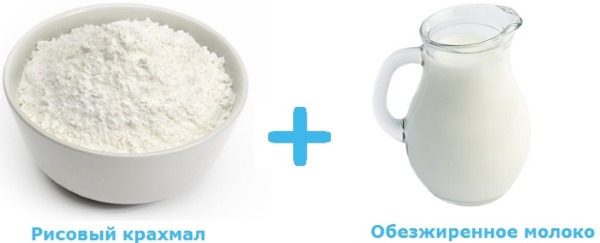
- Pour the prepared mixture into boiling milk, stirring constantly with a spoon.
- Turn off the heat and wait until it cools to 30-35° C.
- Dip a napkin into it.
Sugar
The use of sugar is advisable when products need to be given a voluminous shape.
You will need to prepare the following components:
- 500 ml of water;
- 1 heaped teaspoon of starch;
- 2 tbsp. sugar.
To starch, follow these steps:
- Bring 1 part water to boil.
- Dissolve sugar in 1 cup of warm water, stirring thoroughly with a spoon.
- Mix the 2nd part of cold water with starch until a homogeneous consistency without lumps is obtained.

- Combine liquids containing sugar and starch.
- Pour them in a small stream into boiling water, stirring constantly with a spoon.
- Wait until the paste boils again.
- Turn off the heat and wait until it cools down.
Gloss-starch
The following recipe will tell you how to starch a crocheted napkin so that it becomes stiff and easy to shape. You will need to use glossy starch. The product will look snow-white with a gloss effect.
You will need the following components:
- rice or potato starch – 2.5 tbsp;
- talc – 1.5 tbsp;
- borax – 1 tsp;
- water.

The preparation consists of the following stages:
- Combine all powdered components.
- While stirring, add water until the consistency of sour cream is achieved.
- Lubricate the napkin with this composition completely, including individual places, using a brush or cotton pad. To do this, add borax and talc to the starch. The napkin is not soaked in the solution, but it is applied to the product using a brush or cotton pad.
- Dry the item with an iron, placing several layers of gauze on top.
Aerosol
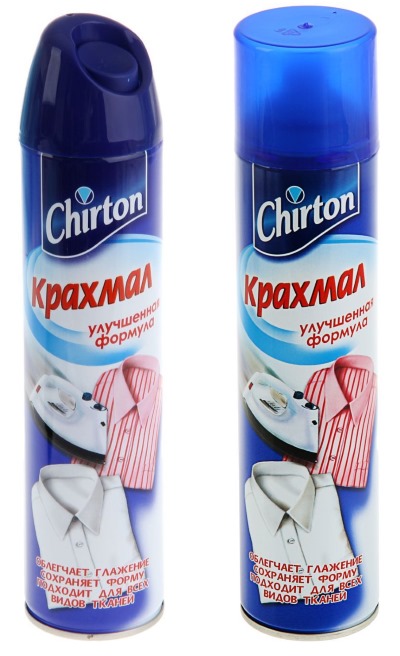
You can easily and quickly starch a napkin using a special aerosol, which already contains starch paste.
To starch napkins, you should follow these steps: the following sequence:
- Moisten the cloth slightly with water.
- Lay it out on a flat surface and secure it with pins.
- Spray the product with Aerosol.
- Iron, covering with several layers of gauze on top.
These napkins will not be too hard and will retain their starchy effect for a short time.
PVA or silicate glue
To obtain hard napkins and give them different shapes, the starching method using PVA glue is suitable.
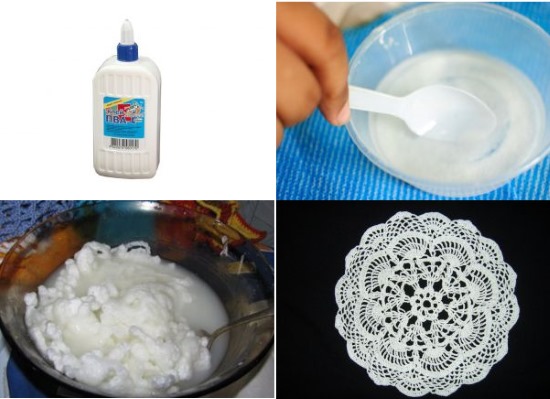
To do this, you need to perform a number of actions:
- Mix glue with water in equal proportions.
- Dip the napkins into this solution and wait about 10-15 minutes until completely soaked.
- Squeeze the items and dry.
- Once they are almost dry, you need to give them the desired shape.
For starching with silicate glue, the procedure is the same. Put 0.5 teaspoon of glue per 2.5 liters of water.
Gelatin
It is good to shape knitted napkins using gelatin.
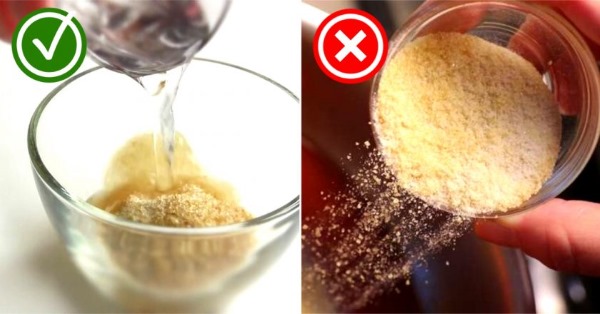
To prepare the solution, you will need to perform the following sequence of actions:
- Take 200 ml of warm water and pour in 2 tbsp of gelatin. Wait until it swells. This will take about 10 minutes.
- Put the water to boil.
- Heat the softened gelatin in a water bath until the grains are completely dissolved.
- Cool the liquid to a temperature of 35-40°C.
- Place a napkin in the solution to soak it.
- Squeeze the product slightly and put it out to dry.
The napkins are firm and do not crumble.
Dry method
You can starch a napkin without soaking it.
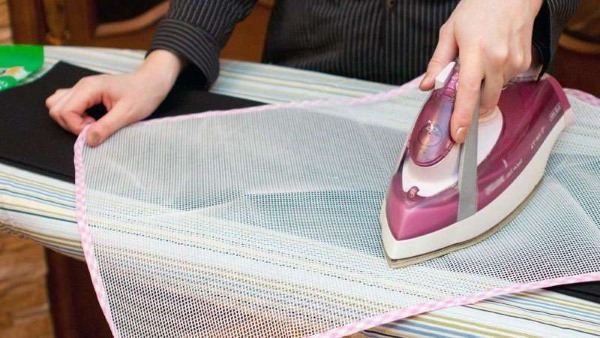
To do this you will need:
- Place the product on white paper or fabric, best secured with pins.
- Sprinkle starch evenly over the product; you can use a sieve.
- Lightly spray the product with water using a spray bottle. The product should become elastic.
- Let it dry or dry it with an iron, covering it with gauze or paper on top.
- Shake the product or remove any remaining powder with a brush.
When using the dry method, the napkins quickly lose their hardness and become the same as they were originally. However, it is good when you need to get a starched napkin in a short time.
To choose the best method for the product, you can experiment using a small knitted sample, then there will be no mistakes.
This process is not considered difficult, but it significantly improves the appearance of the products.
You can use not only traditional potato starch, but also starch obtained from cereal crops, for example:
- rice;
- barley;
- corn;
- wheat.
The cooked paste will differ in its thickness, but the principle and method of processing the napkin will remain the same.
Cold method
How to starch a crochet napkin so it's not too hard using cold starch:
- Pour starch into a container with cold water.
- Mix thoroughly and make sure there are no lumps.
- Place a napkin in the solution and soak for 20-30 minutes.
- Squeeze the napkin and lay it out on a horizontal surface. Secure the edges with pins.
Drying, ironing and storage
It is important not only to starch the product well, but also to dry it correctly. To do this, you need to follow a number of rules.
Getting into the right position
After the napkin is soaked with paste, it must be laid out horizontally. For these purposes, use the surface of a table, ironing board, polystyrene foam or the smooth side of a ceiling tile made of penoplex material.
It is recommended to first lay out a white sheet in several layers or a terry towel. The surface must be smooth, otherwise the product will take on an irregular shape and be wavy. It is not for nothing that the fabric is laid out so that the napkin can be fixed with pins, about 1 cm thick. It should not get wet, otherwise the product will take a long time to dry.
Giving immobility
The napkin is first soaked in paste, then laid out, straightened and fixed with safety pins, pinning them to the ends of the product. This is necessary so that it does not deform, but has the correct shape.
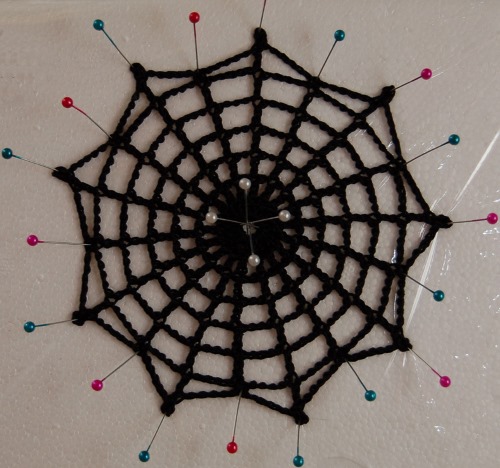
To fix it, you need to perform a series of sequential actions:
- Start giving the correct shape from the middle, securing 4 pins to avoid distortions.
- Stretch one end, measuring the distance with a ruler from the center to the tip, securing with a pin.
- The same actions are carried out with all ends of the napkin. For evenness, it is advisable to take the ends of the napkin located diagonally, constantly measuring the same distances with a ruler. Then the intermediate segments are attached.
Drying
The most optimal conditions are considered to be when the sun's rays fall on the napkin and the room is well ventilated. In some cases, you have to use an iron, covering the product with gauze or white paper.
If the napkin should be voluminous in the form of a vase or plate, then it is recommended to dry it by putting it on a form, having previously covered it with a film. They can be a glass, a bottle or a bowl.
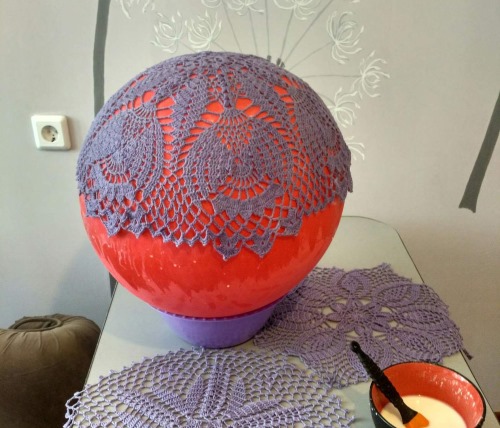
It is convenient to use a balloon as a form. It can be inflated in different sizes, but before putting a napkin on it, it is also recommended to cover it with cling film. It is necessary to dry until completely dry, sometimes it takes about 2 days.
Ironing
Individual napkins will look aesthetically pleasing after steaming and ironing, for this:
- the iron should not be heated too much;
- iron quickly and carefully;
- To prevent the napkin from turning yellow, cover the product with several layers of gauze.
Storage
It is important not only to dry and iron the napkins, but also to store them correctly. The room must be dry: if the humidity is high, the products may become moldy and lose their shape., fungi may start growing on it. If sugar was used, insects (ants) may come running.
Napkins made of what threads cannot be starched
Napkins are knitted from various threads. But only cotton and linen products are well starched and hold their shape.
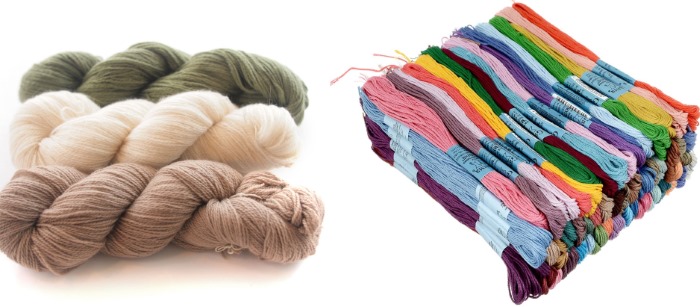
It is not recommended to subject products made from the following fibres to this procedure:
- wool;
- floss;
- silks;
- synthetics.
They will not become hard, starch does not penetrate well between the fibers of these materials. Silk threads may lose their structure. When starching colored and dark napkins, the natural color will be lost, and white spots may appear.
Mistakes and recommendations when starching knitted items
Many housewives make mistakes when starching items. Napkins lose their appearance, become yellow, and dark items become covered with white spots.
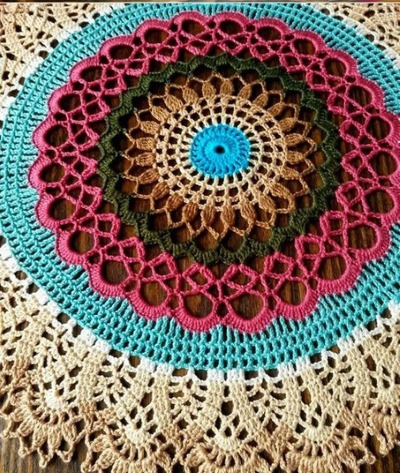
It is advisable to follow the following guidelines to avoid mistakes:
- When it is necessary to starch snow-white napkins, it is better not to use starch and gelatin, because over time they turn yellow. It is better to use skim milk with rice starch.
- If the napkin is knitted from colored or dark threads, it is better not to starch it, so that it does not become covered with whitish spots and stains.
- You should not starch items knitted from synthetics. They may stretch and lose their correct shape.
- It is best to purchase a ready-made starching agent in the form of an aerosol.
- It is not recommended to store a starched napkin in a closet for a long time, as it may turn yellow.
- It is important to remember: after processing with starch, the item cannot be moistened, it will lose its shape, and everything will have to be done again.
- If the edges of the napkin are decorated with fringe, to prevent it from sticking together, it should be held over steam and then combed with a comb.
- To give the napkin a wave shape, you need to wind it around a bottle or thick curlers.
- When using a hot solution, the product becomes solid.
- To iron a napkin without it sticking to the iron, you need to pour in skim milk instead of water.
- To ensure that the item is soaked in the paste faster, it is recommended to place the basin with the item in the microwave for 5 minutes.

If you like to add coziness to the premises using crocheted accessories, then you must definitely know the technique of starching products. To starch a napkin, you need to choose the right method.
When giving the product a three-dimensional shape, it is advisable to use starch with the addition of sugar, salt, gelatin, PVA glue. It is important to preserve its whiteness, shape, fix it and dry it well. Only if you follow the algorithm of thoughtful actions will the product please you with its appearance.
Article formatting:Natalie Podolskaya
Video with starching rules
Video on how to starch a crocheted napkin easily and simply:

Earlier, when I was a child, I starched things like this: I mixed starch in cold water, soaked the thing, then wrung it out slightly, straightened it out and ironed it with a hot iron. It worked great. Now I can't find this method on the Internet, everyone boils paste and soaks it in it. How strange. But most likely, this method went out of life along with our grandmothers).